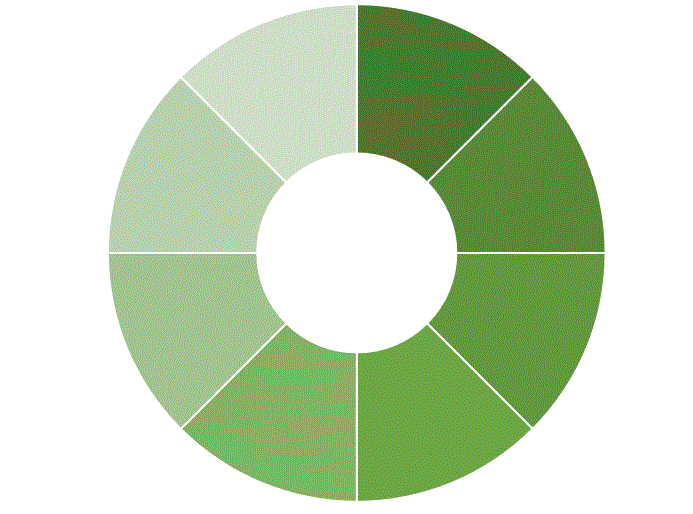
360 Degree Environmental Management
Leadership
Assessment
Outcomes
Actions
Followup
Risk
Assessment
Outcomes
Actions
Followup
Evaluation
Assessment
Outcomes
Actions
Followup
Innovation
Assessment
Outcomes
Actions
Followup
Compliance
Assessment
Outcomes
Actions
Follow-up
Operations
Assessment
Outcomes
Actions
Followup
Support
Assessment
Outcomes
Actions
Followup
Audit
Assessment
Outcomes
Actions
Followup
1. PURPOSE & SCOPE.
The implementation of the 360 Degree Environmental Management program consists of eight core units. As part of our leadership training, in each core unit, a gap analysis is conducted to inform the leadership about the current performance of their environmental management program. The outcome of the gap assessment then forms a plan of action for each core area. These action plans are then presented to the leadership to address. We then conduct follow-ups on agreed action plans.
(1) Context of the organization – gap analysis assessment/ outcomes/action plan/ follow-up
(2) Leadership – gap analysis assessment/ outcomes/action plan/ follow-up
(3) Planning and Risk Management/Innovation – gap analysis assessment/ outcomes/action plan/ follow-up
(4) Support – gap analysis assessment/ outcomes/action plan/ follow-up
(5) Operations – gap analysis assessment/ outcomes/action plan/ follow-up
(6) Performance Evaluation – gap analysis assessment/ outcomes/action plan/ follow-up
(7) Improvement – gap analysis assessment/ outcomes/action plan/ follow-up
(8) Internal Audit–gap analysis assessment/ outcomes/action plan/ follow-up
This system also provides a systems-based thinking approach and framework to enable companies to explore inter-relationships, dynamics, and interconnectedness of company processes and operations. Systems thinking is a holistic approach to analysis where the system is the organization and all environmental, social, and economic externalities, relationships, and partnerships that are associated with the organization become clearer and more visible to leadership. The leadership will then consider whether these relationships are direct, partially direct, or indirect and determine the extent of the impacts associated with these associations. We take leadership through direct impacts and dependencies of the company, where the company has a controlling stake. Partial direct: Where they have worked with partners resulting in impacts and/or dependencies. Indirect, where they have commissioned activities by others or within their supply chain. Or where companies have enabled activities that they have contributed to or which are carried out in their portfolio (e.g., financed) or by customers and other parts of the value chain. The system-based thinking and framework are used across the organization including planning and risk management, innovation, support, operations, performance evaluation, and audit.
We also provide a detailed integrated capital assessment. Integrated capital assessments are assessments that include multiple capitals (Natural Capital, Human Capital, Social Capital, Produced Capital, and Digital Capital). Integrated capital assessments involve measuring and valuing all relevant capitals in terms of impacts and dependencies on them, which explicitly takes into account systems thinking including the interconnections both within and between all of the capitals. The integrated capital assessments provide a deeper stakeholder analysis.
For further information contact us: info@netafrica.be
Further reading
NATURAL CAPITAL – We assess the stock of renewable and non-renewable natural resources that combine to yield a flow of benefits to people. We also assess whether the company supports a precautionary approach to environmental challenges (Principle 7). We also assess whether companies undertake initiatives to promote greater environmental responsibility (Principle 8). We also assess whether companies encourage the development and diffusion of environmentally friendly technologies (Principle 9).
These assessments become outcomes that then convert to action points to address which we then follow up or transfer to their internal audit- if this is already addressed through science-based targets it can be slotted into the natural capital assessment.
SOCIAL CAPITAL – We assess the companies’ networks together with their corporate shared norms, values, and understanding that facilitate cooperation within and among their key stakeholder groups. We also assess whether the company supports and respects the protection of internationally proclaimed human rights (Principle 1) and make sure that they are not complicit in any human rights abuses (Principle 2). These assessments become outcomes that then convert to action points to address which we then follow up on or transfer to their internal audit.
HUMAN CAPITAL – We assess the companies’ knowledge, skills, competencies, and attributes embodied in individuals that contribute to improved performance and well-being. We also assess whether the company upholds the freedom of association and the effective recognition of the right to collective bargaining (Principle 3), and the elimination of all forms of forced and compulsory labour (Principle 4). The effective abolition of child labour (Principle 5). The elimination of discrimination in respect of employment and occupation (Principle 6). These assessments become outcomes that then convert into action points to address which we then follow up on or transfer to their internal audit.
PRODUCED CAPITAL – We assess the companies’ human-made goods and financial assets that are used to produce goods and services consumed in society. We also check that businesses work against corruption in all its forms. (Principle 10).
Main benefits of the 360-degree program:
Value for money – The program is offered to companies to enable 5 members of staff including leadership to attend the program which includes ISO 14001 training, systems thinking, and integrated capital assessment training for 100 USD. The outcomes of the program include o Readiness to implement ISO 14001 Environmental Management program o Implementation of Internal Audit team. o Systems thinking/framework approach to understanding o A deeper understanding of the impacts of key stakeholders through integrated capital assessment.
Legal compliance - Getting ISO 14001 certified ensures you are keeping up to date with legal regulations. Fines for non-compliance with laws and regulations can damage the reputation of the organization. The ISP 14001 ensures that you keep up-to-date with legislation and applicable laws.
Increased reputation with consumers - More and more consumers are ‘going green, with half of the digital consumers saying environmental concerns impact their purchasing decisions. Getting ISO 14001 certified displays to your customer that you have an active commitment to reducing your environmental impact.
Competitive advantage - With the above in mind, the ISO 14001 certification can help set you apart from competitors or help you keep up if they are already certified. This also holds if your organization is bidding for the tender. With more and more businesses getting ISO 14001 certified, your organization mustn’t fall behind.
Reduce waste - The standard aims to reduce the amount of waste that organizations are producing. From the unnecessary running of machinery to a lack of training causing excess materials to be left, the standard aims to identify and mitigate all waste. By using more renewable energy sources and energy-saving processes your company becomes more efficient as a result.
Reduce costs - Naturally, an increase in efficiency will lead to reduced costs of running your business. The cost of waste management should go down, just as the need for the processing and removal of waste will be lessened.
Reduced insurance costs - Some companies might find that getting certified in ISO 14001 will reduce insurance premiums. The certification proves your organization is performing strong due diligence in managing its environmental impact, which means there is less chance of you being found liable for environmental negligence.
The 360-degree management program demonstrates a commitment to sustainability.
Redefines a sharper-focused company vision, policies, and strategies, with a cycle of continuous assessment embedded within leadership and within performance evaluation that improves sustainability targets, and indicators (Principle 8).
The 360-degree management program is a flexible adaptable program that can be used in conjunction with other programs such as Science Based Target assessments – which can be inserted into the risk analysis assessment of the program.
The 360-degree management program assists companies to train and implement an internal audit team to measure, track and communicate progress on incorporating sustainability principles into business practices - (Principle 8).
The 360-degree management program assists companies in AI, machine learning, and data science to Implement environmentally friendly technologies to reduce the use of raw materials leading to increased efficiency - (Principle 9).
The 360-degree management program assists companies in technology innovation to create new business opportunities and help increase the overall competitiveness of the company - (Principle 9).
The 360-degree management program assists companies in technologies that use materials more efficiently and cleanly and can be applied to most companies with long-term economic and environmental benefits - (Principle 9).
ONBOARDING
Introduction to the 360 Degree Leadership Program.
Welcoming participants to the program elements and organization
We start by welcoming participants to the program elements and organization. We also explain how we conduct assessments, outcomes, actions, and follow-ups. We provide a detailed explanation of the importance of completing action points identified as critical. Achieving success requires your organisation to address the necessary action points at the end of each session. Identifying incremental milestones to be taken is also a good approach to address issues highlighted during the assessment and outcomes phase.
Learning outcome /actions/follow-up: Understanding the importance of and how the program assessments, outcomes, actions, and follow-ups are planned and delivered.
45 Degrees Leadership
In this section, we provide you and your team with personalised sessions and workshops to start you on your journey to a more regenerative and integrative thinking approach to how you operate and exist within your organisational space. We will have a set planned focus for all our 1-2-1 or team sessions. All our discussions are issues specific to your organisation with a clear focus on how we can regenerate and integrate your entire organisation. We use a number of resources to guide you through the process. The outcomes of these assessments will provide specific, measurable, achievable, realistic, and timely incremental improvements to your leadership to support the growing needs of your team that supports the atmosphere of mutual support and respect. It will also support the removal of obstacles to your team's effectivity. We also support you in setting clear goals that your team can identify with and internalize as their own. We also assess your delegation skills; and how you set environmental objectives and implement environmental policies. Your approach to environmental management.
We also provide assessment tools to understand your internal and external stakeholders, their needs, and expectations. We assess the organizational roles, responsibilities, and authorities internally and externally.
Assessment outcome /actions / follow-up: Leadership and management commitment.
90 Degrees Leadership - In this section, we learn about the biophysical features of your organization. In areas such as your site name (the official name of the site and catchment), the area, and boundary (size and variation, range and average values), location (projection system, map coordinates, map centroid, elevation), Geomorphic setting (where it occurs within the landscape, linkage with another aquatic habitat, biogeographical region). General description (shape, cross-section, and plan view), Climate – zone, and major features. Soil (structure and colour), water regime (e.g., periodicity, the extent of flooding and depth, source of surface water, and links with groundwater). Water chemistry (e.g., salinity, pH, colour, transparency, nutrients).
We also focus on issues such as vegetation zones and structure, animal populations and distribution, special features such as rare/endangered species). We also analyse and identify your activities, products, and services. Identify your environmental aspects, impacts, and lifecycle analysis. Risk assessment and controls.
We will also introduce you to the ISO 14001 Environmental Management System.
Assessment outcome /actions / follow-up:
An understanding of your current environmental management system;
Initial Environmental Review & Gap Analysis.
An introduction to the ISO 14001 environmental management system. Opportunities to implement an environmental management system to address your risks. Environmental aspects; and impacts.


Leadership


Leadership & Risk Management
45 Degrees
LEADERSHIP & ORGANISATIONAL ASSESSMENTS
(Personalised Online Workshop)
We ask you to attend a online personalised workshop with two senior leaders and two members of staff to complete a leadership and organisational assessments with live feedback on outcomes and targeted actions to complete and scheduled follow-up sessions.
90 Degrees
LEADERSHIP & RISK MANAGEMENT
(face-to-face group training or live webinar)
We will work with you to learn more about the biophysical features of your organization.
We also provide you with support to analyse and identify your activities, products, and services. Identify your environmental aspects, impacts, and lifecycle analysis of environmental aspects. We introduce you to environmental management ISO 14001.
180 Degrees
LEADERSHIP, RISK, INNOVATION & COMPLIANCE
On-site - follow-up continuous improvement, mentorship, consultancy.
Green innovation, review and gap analysis
we also review your compliance obligations discussing the environmental legal framework, environmental due diligence, national and international law and the importance of compliance in developing your environmental management system.
360 Degrees
LEADERSHIP, RISK, INNOVATION & COMPLIANCE, SUPPORT, OPERATIONS, EVALUATION, AND AUDIT.
On-site - follow-up continuous improvement, mentorship, consultancy.
Opportunity for environmental audit and certification (ISO 14001 Environmental Management)
180 Degrees Leadership - In this section, we review your compliance obligations discussing the environmental legal framework, environmental due diligence, national and international law, and the importance of compliance in developing your environmental management system. We also look into your research and development budget, and strategy. We look at how innovation, AI, data science and machine learning could boost your company performance.
We also recommend investment strategies.
Assessment outcome /actions / follow-up:
Perform an Innovation Review & Gap Analysis. Perform a compliance assessment and review.
360 Degrees Leadership
Assessment outcome /actions / follow-up:
Plan your ISO 14001.
Train your organization on ISO 14001 Environmental Management System (EMS)
Document and implement your ISO 14001 EMS. The audit you EMS.
Register for an EMS Audit
Get Certified for ISO 14001 EMS


Leadership, Risk, Innovation and compliance

Leadership, Risk, Innovation, compliance
support, operations, evaluation and audit


